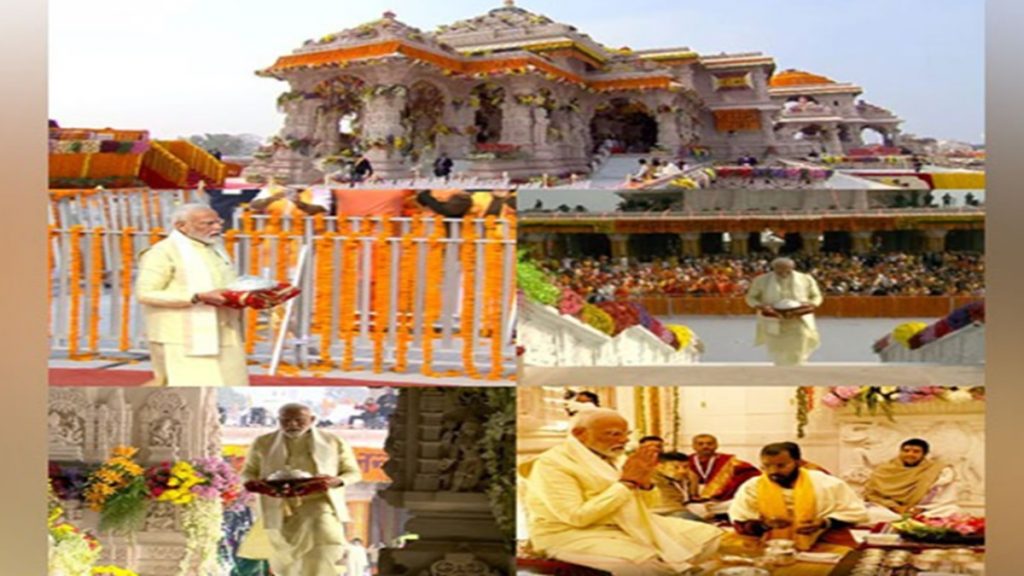New Delhi: Prime Minister Narendra Modi who performed the Pran Pratishtha ceremony at the Shri Ram Janmaboomi Temple in Ayodhya on Monday was seen dressed in a cream-coloured traditional kurta-pajama, matching jacket and a stole.
Inside the intricately carved white marble temple PM Modi climbed up a series of stairs to reach the garbha griha for the the pran-pratistha ceremony.
The Prime Minister who had undertaken an 11-day Anushtan in the run-up to the day led the ‘Pran Pratishtha’ rituals, which began with a prayer to Lord Vishnu.
#WATCH | ‘Aarti’ of Ram Lalla idol underway at the Shri Ram Janmaboomi Temple in Ayodhya#RamMandirPranPrathistha pic.twitter.com/fEmJlKsDsF
— ANI (@ANI) January 22, 2024
Amidst hymns and vedic chants of mantras by priests, PM Narendra Modi offered prayers to Ram Lalla. The 51 inch tall idol was unveiled at the Ram Temple in Ayodhya during the Pran Pratishtha ceremony.
The Ram Temple Pran Pratishtha ceremony was performed in the presence of Uttar Pradesh Chief Minister Yogi Adityanath, RSS chief Mohan Bhagwat among others.
“The divine moment of Pran Prathishta of Shri Ram Lala in Ayodhya Dham is an emotional moment for everyone. It is my good fortune to be part of this unique programme. Jai Siyaram,” PM Modi said in a tweet.
Outside, Indian Air Force (IAF) choppers showered flower petals over Shri Ram Janmaboomi Temple premises as idol of Ram Lalla was unveiled. The air in the premises was filled with chants of ‘Jai Sri Ram’ by invitees. Over 8,000 guests have been invited for the ceremony at the grand temple.
Representatives of all major spiritual and religious sects of the country are attending the historic cerenmony . People from all walks of life including representatives of various tribal communities are also attending the ceremony. Prime Minister will address this distinguished gathering on the occasion.
#WATCH | Ram Lalla idol at the Shri Ram Janmaboomi Temple in Ayodhya
#RamMandirPranPrathistha pic.twitter.com/shlEyziWyw
— ANI (@ANI) January 22, 2024
The magnificent Shri Ram Janmbhoomi Mandir is constructed in traditional Nagara style. Its length (east-west) is 380 feet; width 250 feet and height is 161 feet; and is supported by a total of 392 pillars and 44 doors. The pillars and walls of the temple showcase intricately sculpted depictions of Hindu deities, gods, and goddesses. In the main sanctum sanctorum at ground floor, the childhood form of Bhagwan Shri Ram (the idol of Shri Ramlalla) has been placed.
The main entrance to the Mandir is situated on the eastern side, which can be approached by ascending 32 stairs through the Singh Dwar. There are a total of five Mandaps (Halls) in the Mandir – Nritya Mandap, Rang Mandap, Sabha Mandap, Prathana Mandap and Kirtan Mandap. Near the Mandir is a historic Well (Sita koop), dating back to the ancient era.
In the southwestern part of the Mandir complex, at Kuber Tila, the ancient Mandir of Bhagwan Shiv has been restored, along with the installation of a statue of Jatayu.
The foundation of the Mandir has been constructed with a 14-meter- thick layer of roller-compacted concrete (RCC), giving it the appearance of artificial rock. No iron is used anywhere in the Mandir. For protection against ground moisture, a 21-foot-high plinth has been constructed using granite.
The Mandir complex has a sewage treatment plant, water treatment plant, water supply for fire safety and an independent power station. The Mandir has been constructed employing the country’s traditional and indigenous technology.

